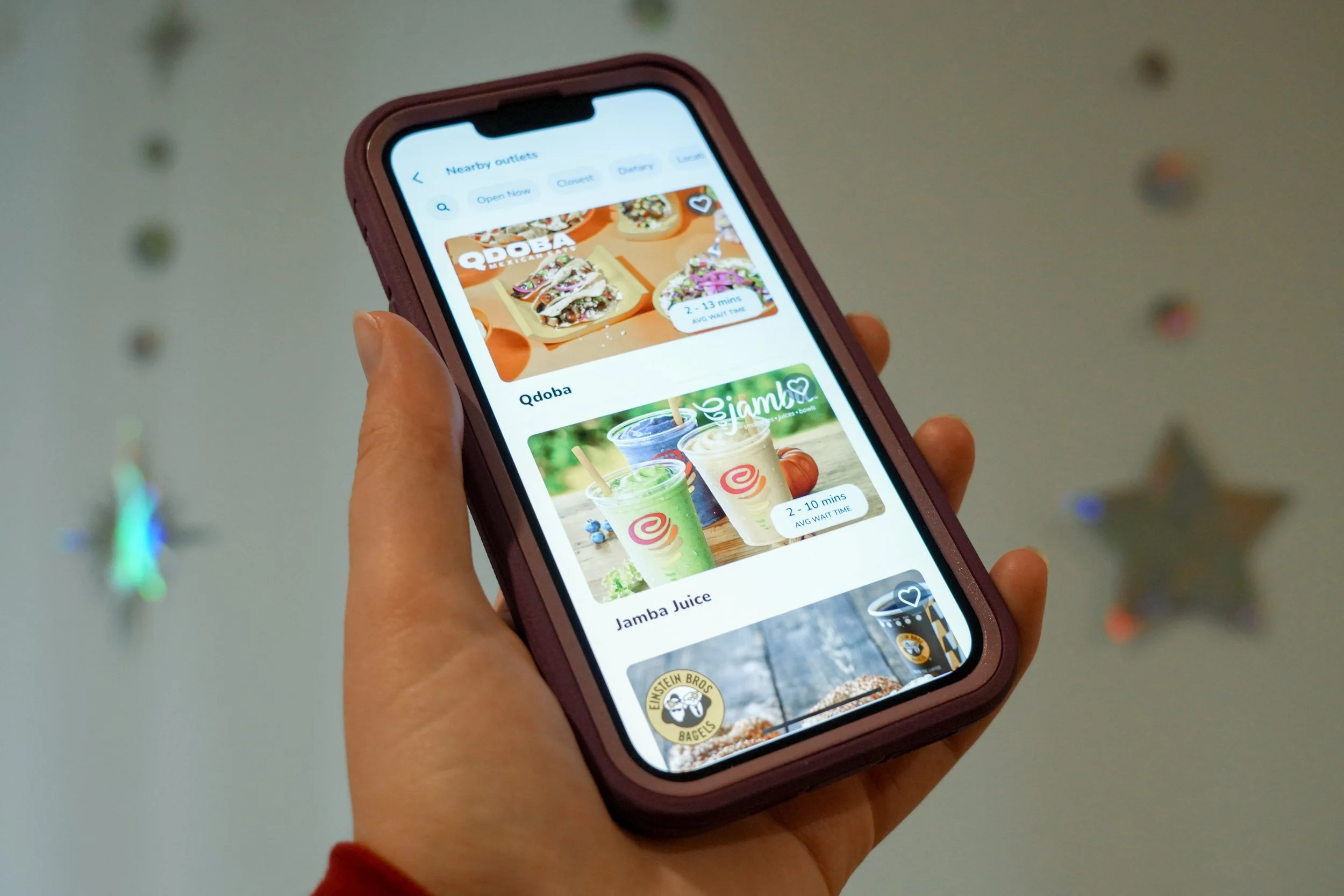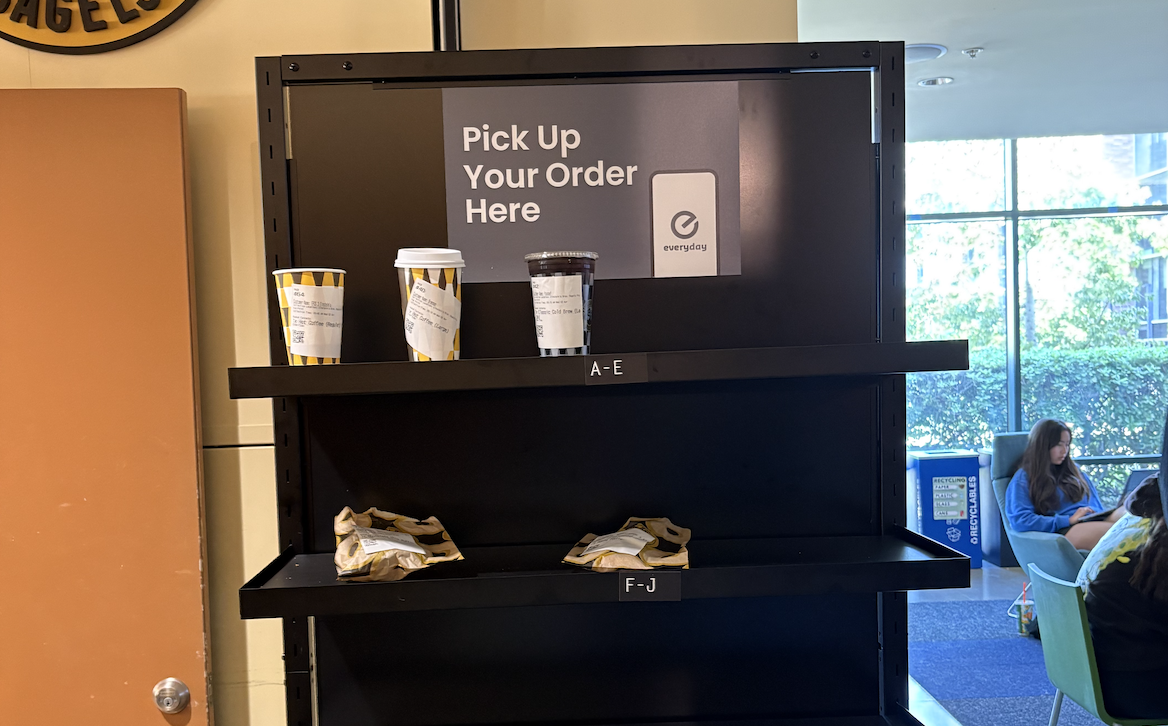Dining going digital: New Everyday app launches for campus dining
Photo Illustration by Samantha Rosinski, Staff Photographer
March 31 marked the roll out of the Everyday app at Chapman, allowing students to pre-order food at on-campus restaurants.
This innovative system was implemented to transform the campus dining experience, including features such as mobile and kiosk ordering, a digital payment method and the opportunity to personalize orders.
The app can be utilized at Jamba Juice, SubConnection, Qdoba, Einstein’s Bros Bagels, the Rotunda Cafe, the Digital Media Arts Center and Doy’s Place. Students can also attach their Panther Bucks to the digital payment feature to pay for their orders.
The Panther tested the app a few days after its release, looking to see how intuitive it is and if there’s pick-up time accuracy.
Using the welcoming $5 voucher — an incentive for students to download the app — the $2.29 bagel was free of charge and, upon ordering, the app gave a pick-up time estimate of 15 minutes. Promptly at the 15-minute mark, the bagel was delivered.
Rodney Reed, resident district manager for Sodexo Services, said that he wants to improve students’ dining experience and this app aims at achieving just that.
“The adaptation of the app has been very strong,” said Reed. “We have a lot more people using the app now than we have had in previous attempts in this type of service. We have had a lot of great feedback on it.”
Over spring break, amid all the new installations for this app, customer service employees prepared for the bustle of student orders.
“We had a customer service class right before spring break and training for our employees,” said Reed. “We also had a team of ten different people come in after we opened back up to help train our employees on what the changes would look like with the app and how it would impact them.”
Carlos Campos, a Jamba Juice employee, shared his thoughts about Everyday and how he sees this app helping out students.
“Back then, we had to go back and forth like headless chickens. But this makes it a lot easier, so we can mostly just focus on the drinks” Campos said.
However, the app appears to be in its developing phase, and Sodexo is receiving feedback to improve features such as the user interface and system performance.
Rachel Nagashima, a third-year graphic design major, told The Panther, “It works for the most part, but I think that you can tell that it's new, it's still in its developing phase and it’s not quite there yet. It doesn’t mean that it doesn’t have potential.”
For example, Jamba employees Campos and Brisien Manzo shared that the time estimates on the mobile orders depend on the product, not the customer traffic. The estimates are automatically displayed on employee tablets and to Everyday customers, sometimes not reflecting the necessary time to prepare the order, especially in rush periods.
Photo by Maya Hawks, Staff Reporter
“My order pick-up time was pretty late,” said Erin Shaw, a sophomore theatre major. “Collection time was 10:30 a.m. and it is currently 10:36.”
Shaw thinks there can be more organization with the new system.
“There's a shelf with all of the orders, and some of them, it's been five hours and they have not been picked up. Because students are either late for class and just give up on it, or they have a class right before and don’t have time to get it.”
Photo by Maya Hawks, Staff Reporter
Nagashima identified different ways that the app could improve its dynamics, such as adding gradients, drop shadows and reducing the amount of emojis. Nagashima also pointed out the stacked endless-scroll advertisements for food items and recipes.
“I feel like rather than having all your ads in a banner down here, you can have it scroll diagonally,” Nagashima said. “That way, it takes up less screen space, because when you think of users using ads, you don’t want them to scroll too much.”
Although Everyday is optimizing the “grab-and-go” model, the change is leaving students longing for the social interaction that comes with the Chapman dining experience.
“I love how they added the machines for convenience for students who are in a rush because I found myself in that position at times,” freshman environmental science and policy major Rayna Carranza told The Panther. “But I’ll say that I mainly go to Einstein’s because I love the people that work there. So I mostly go (to the cashier) when I have time just to say hi to everybody, and it really builds a community. So I feel like the machine is a good thing for students who need it, but the cashier should still be there.”
Reed plans to maintain a hybrid-model of human cashiers and kiosks
“We have got cashiers for every one of the places that we put these,” Reed said. “If it does go to where no one is using the cashier anymore, then maybe that cashier will become a sandwich maker or a smoothie maker. This is more of an exercise to improve our efficiency, not to change our staffing model.”



